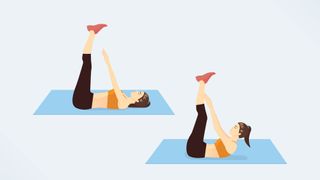If you’re tired of crunches and looking for a new way to increase the intensity of your next ab workout, we have a simple solution: Raise your legs up to the ceiling. Vertical leg crunches are a variation of the crunch that helps you target more of your core muscles.
While the basic crunch targets the rectus abdominis, or outer six-pack muscles, the vertical leg crunch also targets the deeper transverse abdominal muscles, internal and external obliques, and lower back muscles.
To learn more about the effects of the vertical leg crunch, I’ve rolled out one of the best yoga mats, and added it to my workout routine every day for a week. The simple-looking move requires only your body weight and can be performed virtually anywhere.
As always, what works for me may not be right for you and your body. If you’re new to exercise, have suffered a back injury, or are getting back into shape after a break, it’s a good idea to check your form with a personal trainer before increasing the number of reps.
How to do a vertical leg crunch
Ready to start? The key to this exercise is moving with proper form. Here’s how to do an upright leg crunch with proper form:
- Start by lying on your back. He put his hands gently behind his head.
- Raise your legs together, lifting them towards the ceiling, with a slight bend in the knee. Make sure your lower back is pressed into the floor and there is no space between your back and the mat.
- Squeeze your core, thinking about sucking your belly button into your spine.
- Curl your head, neck and shoulder blades off the mat, keeping your legs straight. Don’t let them swing from side to side.
- Pause and hold the movement when your shoulders are off the floor.
- Lower your upper body onto the mat, moving slowly and with control.
- Keep your legs raised, don’t let them crash into the carpet.
- This is a repeat.
The key to this exercise is to move slowly and with control – be sure to think about contracting your abs throughout the exercise to keep them engaged.
I did vertical leg crunches every day for a week—here’s what happened
As a fitness editor, I’m no stranger to a workout challenge: Here at Tom’s Guide’s Fitness Desk, we frequently try all sorts of weird and wonderful week-long challenges to learn more about exercise. That said, as a reminder, you shouldn’t train your abs every day of the week—your body needs time to rest and recover between workouts.
Here’s what I learned from a week of vertical leg crunches:
They are much harder than regular crunches
While the only difference between this and a basic crunch is the leg lifts, it only took me a few reps on the first day of this challenge to realize that this variation was much more challenging than regular crunches. On day one, I opted for 50 reps, split into five sets of 10 reps. When I finished, I could feel my core had been working hard.
By the end of the week, I had challenged myself to increase the intensity of the movement by adding reps to my daily workout, but also by changing the position of my arms. The movement can be made more difficult by extending your arms towards your feet, trying to touch your toes at the start of each rep. On the last day I held one of best adjustable dumbbells between my hands as I reached towards my toes.
I had to focus on my form
As with many of these week-long challenges, I filmed my form and asked a personal trainer friend to take a look at how I was doing. I suffer from back pain after years of sciatica, so I was very conscious of keeping my back pressed against the mat as I moved, however, I found that I also had to focus on my legs.
Your legs swinging from side to side during the exercise is a sign that you aren’t engaging your core properly. If you struggle to keep your legs still, cross one leg over the other while doing crunches to stabilize them.
It’s also important to make sure you don’t use momentum to pull your head forward, as this can put extra strain on your neck. Your hands should only be resting lightly on your head, and you should avoid neck pulling as you crunch. Keep your head and neck relaxed and make sure the movement is coming from your core.
I will add them to my workouts in the future
What did a week of vertical leg crunches teach me about this movement? It’s great for working my core and I will definitely be adding it to my abs workouts in the future. As with many of these challenges, I found that by performing the move before heading out for a run, I was able to better engage my core throughout the move, keeping my torso upright and running in better form. My abs hurt and I could tell I had been working hard.
Obviously there were no visible changes in my body, although that wasn’t my goal: Strong abs help you walk with better posture, protect your spine, lift heavier weights, and run faster.
That said, if visible abs are your goal, no amount of crunches can make that happen. Instead, you’ll need to focus on your body fat percentage, which can be influenced by your diet, stress levels and hormones, as well as exercise. Here you are how to calculate body fat percentageand why it matters.
I will continue vertical leg crunches in my ab workouts in the future, but I’m relieved I don’t have to do 50 more tomorrow.
More from Tom’s Guide
#vertical #leg #crunches #day #abs #felt #results

